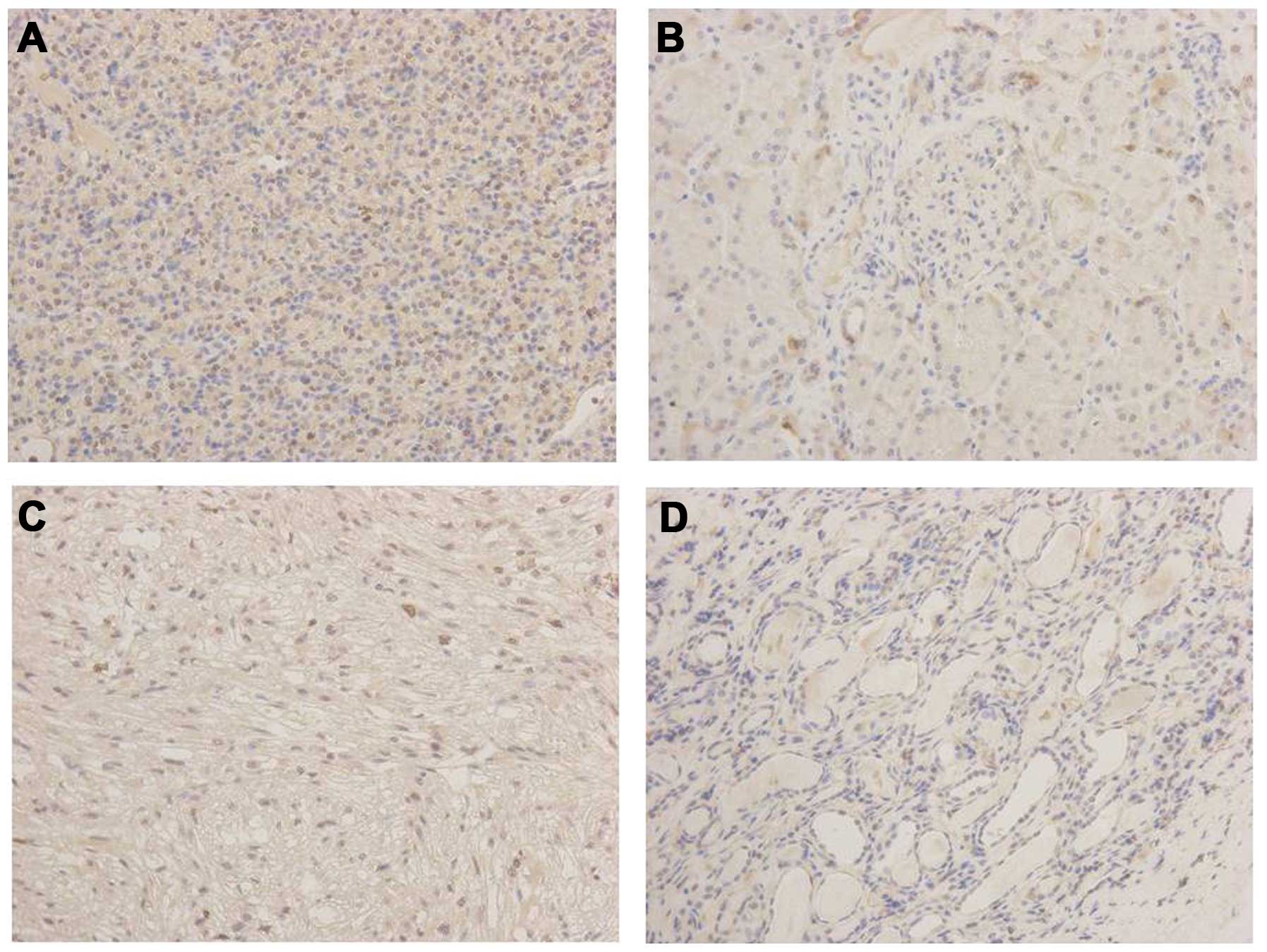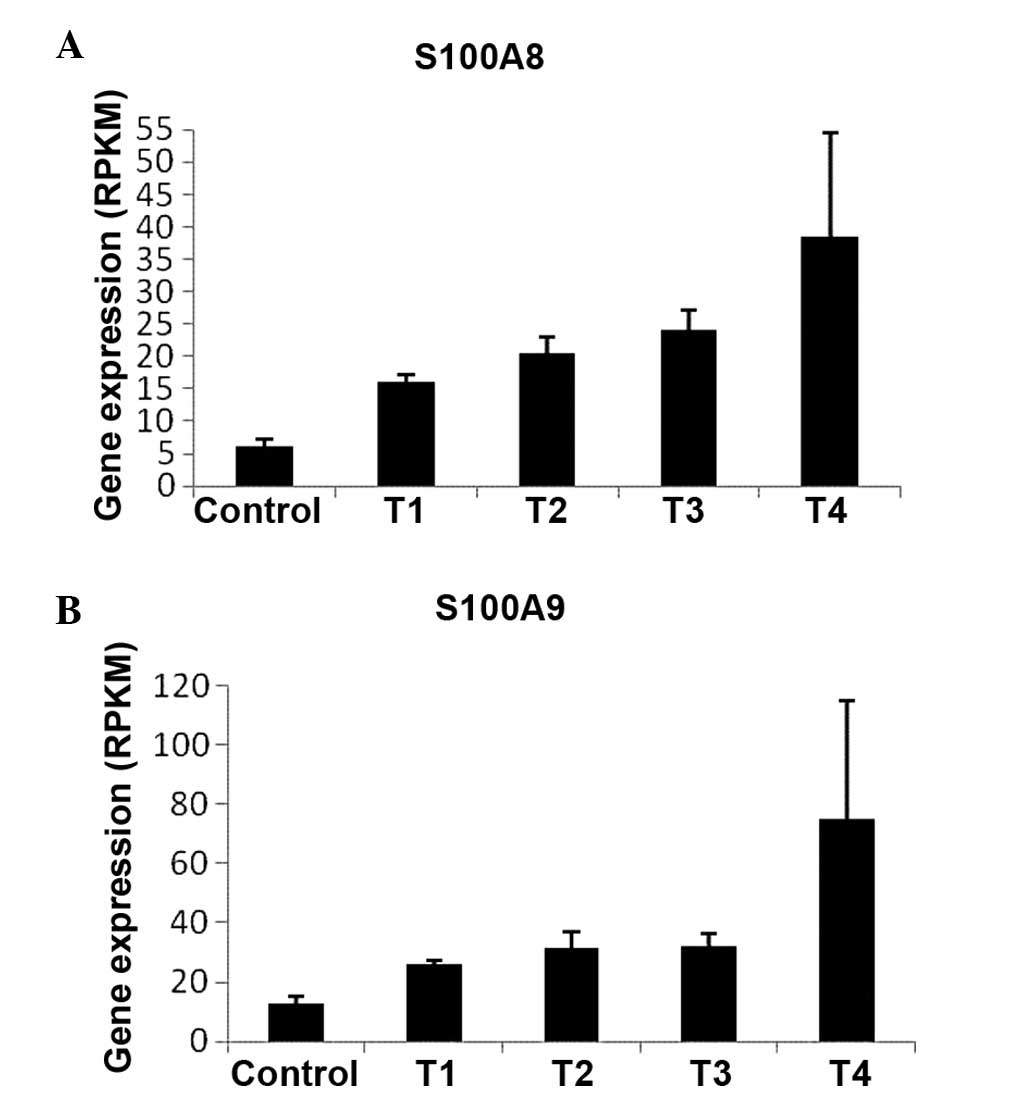|
1
|
Weiss RH and Lin PY: Kidney cancer:
identification of novel targets for therapy. Kidney Int.
69:224–232. 2006. View Article : Google Scholar : PubMed/NCBI
|
|
2
|
Vogelzang NJ, Priest ER and Borden L:
Spontaneous regression of histologically proved pulmonary
metastases from renal cell carcinoma: a case with 5-year followup.
J Urol. 148:1247–1248. 1992.PubMed/NCBI
|
|
3
|
Schendel DJ, Oberneder R, Falk CS, et al:
Cellular and molecular analyses of major histocompatibility complex
(MHC) restricted and non-MHC-restricted effector cells recognizing
renal cell carcinomas: Problems and perspectives for immunotherapy.
J Mol Med (Berl). 75:400–413. 1997. View Article : Google Scholar
|
|
4
|
Donato R: S100: a multigenic family of
calcium-modulated proteins of the EF-hand type with intracellular
and extracellular functional roles. Int J Biochem Cell Biol.
33:637–668. 2001. View Article : Google Scholar : PubMed/NCBI
|
|
5
|
Heizmann CW, Fritz G and Schäfer BW: S100
proteins: structure, functions and pathology. Front Biosci.
7:d1356–d1368. 2002. View
Article : Google Scholar : PubMed/NCBI
|
|
6
|
Roth J, Vogl T, Sorg C, et al:
Phagocyte-specific S100 proteins: a novel group of proinflammatory
molecules. Trends Immunol. 24:155–158. 2003. View Article : Google Scholar : PubMed/NCBI
|
|
7
|
Cheng P, Corzo CA, Luetteke N, et al:
Inhibition of dendritic cell differentiation and accumulation of
myeloid-derived suppressor cells in cancer is regulated by S100A9
protein. J Exp Med. 205:2235–2249. 2008. View Article : Google Scholar : PubMed/NCBI
|
|
8
|
Gebhardt C, Németh J, Angel P, et al:
S100A8 and S100A9 in inflammation and cancer. Biochem Pharmacol.
72:1622–1631. 2006. View Article : Google Scholar : PubMed/NCBI
|
|
9
|
Turovskaya O, Foell D, Sinha P, et al:
RAGE, carboxylated glycans and S100A8/A9 play essential roles in
colitis-associated carcinogenesis. Carcinogenesis. 29:2035–2043.
2008. View Article : Google Scholar : PubMed/NCBI
|
|
10
|
Vogl T, Gharibyan AL and Morozova-Roche
LA: Pro-Inflammatory S100A8 and S100A9 proteins: self-assembly into
multifunctional mative and amyloid complexes. Int J Mol Sci.
13:2893–2917. 2012. View Article : Google Scholar
|
|
11
|
Marenholz I, Heizmann CW and Fritz G: S100
proteins in mouse and man: from evolution to function and pathology
(including an update of the nomenclature). Biochem Biophys Res
Commun. 322:1111–1122. 2004. View Article : Google Scholar : PubMed/NCBI
|
|
12
|
Schäfer BW, Wicki R, Engelkamp D, et al:
Isolation of a YAC clone covering a cluster of nine S100 genes on
human chromosome 1q21: rationale for a new nomenclature of the S100
calcium-binding protein family. Genomics. 25:638–643. 1995.
View Article : Google Scholar : PubMed/NCBI
|
|
13
|
Zimmer DB, Wright Sadosky P and Weber DJ:
Molecular mechanisms of S100-target protein interactions. Microsc
Res Tech. 60:552–559. 2003. View Article : Google Scholar : PubMed/NCBI
|
|
14
|
Mueller A, Schäfer BW, Ferrari S, et al:
The calcium-binding protein S100A2 interacts with p53 and modulates
its transcriptional activity. J Biol Chem. 280:29186–29193. 2005.
View Article : Google Scholar : PubMed/NCBI
|
|
15
|
Kriajevska M, Tarabykina S, Bronstein I,
et al: Metastasis-associated Mts1 (S100A4) protein modulates
protein kinase C phosphorylation of the heavy chain of nonmuscle
myosin. J Biol Chem. 273:9852–9856. 1998. View Article : Google Scholar : PubMed/NCBI
|
|
16
|
Salama I, Malone PS, Mihaimeed F, et al: A
review of the S100 proteins in cancer. Eur J Surg Oncol.
34:357–364. 2008. View Article : Google Scholar
|
|
17
|
Emberley ED, Murphy LC and Watson PH: S100
proteins and their influence on pro-survival pathways in cancer.
Biochem Cell Biol. 82:508–515. 2004. View
Article : Google Scholar : PubMed/NCBI
|
|
18
|
Heizmann CW, Ackermann GE and Galichet A:
Pathologies involving the S100 proteins and RAGE. Subcell Biochem.
45:93–138. 2007. View Article : Google Scholar
|
|
19
|
Hermani A, de Servi B, Medunjanin S, et
al: S100A8 and S100A9 activate MAP kinase and NF-kappaB signaling
pathways and trigger translocation of RAGE in human prostate cancer
cells. Exp Cell Res. 312:184–197. 2006. View Article : Google Scholar
|
|
20
|
Hermani A, Hess J, de Servi B, et al:
Calcium-binding proteins S100A8 and S100A9 as novel diagnostic
markers in human prostate cancer. Clin Cancer Res. 11:5146–5152.
2005. View Article : Google Scholar : PubMed/NCBI
|
|
21
|
Ott HW, Lindner H, Sarg B, et al:
Calgranulins in cystic fluid and serum from patients with ovarian
carcinomas. Cancer Res. 63:7507–7514. 2003.PubMed/NCBI
|
|
22
|
Ghavami S, Rashedi I, Dattilo BM, et al:
S100A8/A9 at low concentration promotes tumor cell growth via RAGE
ligation and MAP kinase-dependent pathway. J Leukoc Biol.
83:1484–1492. 2008. View Article : Google Scholar : PubMed/NCBI
|
|
23
|
Moon A, Yong HY, Song JI, et al: Global
gene expression profiling unveils S100A8/A9 as candidate markers in
H-ras-mediated human breast epithelial cell invasion. Mol Cancer
Res. 6:1544–1553. 2008. View Article : Google Scholar : PubMed/NCBI
|
|
24
|
Ichikawa M, Williams R, Wang L, et al:
S100A8/A9 activate key genes and pathways in colon tumor
progression. Mol Cancer Res. 9:133–148. 2011. View Article : Google Scholar : PubMed/NCBI
|
|
25
|
Rafii S and Lyden D: S100 chemokines
mediate bookmarking of premetastatic niches. Nat Cell Biol.
8:1321–1323. 2006. View Article : Google Scholar : PubMed/NCBI
|
|
26
|
Hiratsuka S, Watanabe A, Aburatani H, et
al: Tumour-mediated upregulation of chemoattractants and
recruitment of myeloid cells predetermines lung metastasis. Nat
Cell Biol. 8:1369–1375. 2006. View
Article : Google Scholar : PubMed/NCBI
|
|
27
|
Ozbek E, Aliskan T, Otunctemur A, et al:
Comparison of tumor grade and stage with nuclear factor kappa b and
p38 mitogene activated protein kinase expressions in renal cell
cancer. Arch Ital Urol Androl. 84:53–60. 2012.PubMed/NCBI
|
|
28
|
Pal SK, Williams S, Josephson DY, et al:
Novel therapies for metastatic renal cell carcinoma: efforts to
expand beyond the VEGF/mTOR signaling paradigm. Mol Cancer Ther.
11:526–537. 2012. View Article : Google Scholar : PubMed/NCBI
|














